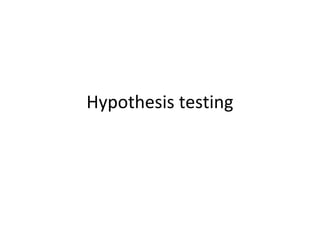
Hypothesis testing
- 2. • Hypothesis- *A tentative explanation for an observation, phenomenon, or scientific problem that can be tested by further investigation. *Something taken to be true for the purpose of argument or investigation; an assumption. *An educated guess based on observation. Eg: Avogadro’s hypothesis Theory- Explain a large class of observations through a model and have predictive capability which can be tested Eg: Einstein’s theory of relativity Law- Generalizes a body of observations -A statement of fact meant to describe, in concise terms, an action or set of actions. It is generally accepted to be true and universal Eg: Newton’s Law of gravitation
- 3. • Null hypothesis: the assumption we wish to test Ho • Alternate hypothesis : when we reject the null hypothesis • Type 1 error: Rejecting a null hypothesis when it is in fact true • Type 2 error: Accepting a null hypothesis when it is false
- 4. • The roofing contract for a sports complex requires the roofing sheets to be 0.04 inches thick. The sports complex samples a lot of 100 sheets from a supply of 10,000 sheets and finds the sample mean is 0.0408 inches. From past experience it is known that these sheets come from a thickness population with standard deviation of 0.004 inches. On the basis of the sample data the sports complex must decide whether or not to accept the consignment of 10,000 sheets
- 5. • The basic question is, “if the true mean is 0.04 what are the chances of getting a sample with a mean thickness of 0.0408?” If the probability of getting such a sample is very low, then we must conclude that the true mean is not really 0.04
- 6. • Calculate standard error of the mean • Calculate z=2 • So probability of the sample mean being less than 0.0392 or larger than 0.0408 is 4.5%
- 7. • A manufacturer supplies axles for trucks. These axles must be able to withstand a 80000 psi in stress tests, but an excessively strong axle will increase production costs. A sample of 100 axles from production has a mean strength of 79600 psi. Experience indicates that the standard deviation of the strength of the axles is 4000 psi. If the axle manufacturer uses a significance of 0.05, should he accept the axles?
- 8. • Ho- The axles are from a population with a mean of 80,000 • H1- The true mean is not 80,000